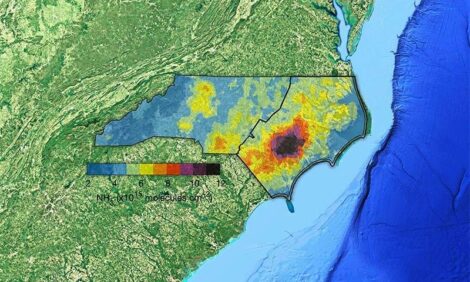



World Pork Expo: Soybean meal can help beat the summer carcass dip
Experts urge swine producers and nutritionists to start planning in December to combat summer carcass weight loss and capitalize on peak market pricesDr. Bart Borg, vice president of Feed and Nutrition at Passel Farms, and Dr. David Rosero, assistant professor at Iowa State University, spoke to The Pig Site’s Sarah Mikesell at the Lessons in Swine Nutrition seminar titled Mitigating the Costly Summer Dip and Economic Impact hosted by US Soy at World Pork Expo in Des Moines, Iowa, USA.
Dr. Borg, to what extent does the summer heat impact pig carcass weight?
Over the years, it's been variable, and I'll describe that a little bit more here in a minute. Some large systems summaries have shown anywhere from 7 to 10 pounds of carcass weight loss can occur during the July–August time period.
US Soy recently funded a large-scale feeding trial in Iowa last summer. If you were in Iowa last summer, you'll remember that we had a very cool summer. The results of that 100,000-pig study were directionally correct, but we know that when we have cooler weather, pigs will gain better so the response was a little less.
Even though it was cooler, it still proved your point about the summer dip, right?
Yes, all the indicators of daily gain and other parameters were going in the right direction. Just the impact was a little bit less because of cooler weather during the study.
Do producers face this issue year-in and year-out, or is it only under more extreme heat conditions?
The more extreme the heat, the worse it will be. As I just indicated, we have an example recently with a cool summer, but it is still part of the consideration of using soybean meal as a tool to mitigate that summer dip. You need to be a meteorologist or have a crystal ball to really get it right, but most of the time, we'll have summer heat.
What are the economic implications to producers from this summer dip?
There are lots of variables to think about with this question. We must consider the input costs of corn, soy and distillers dried grains with solubles (DDGs) for feeding the pig. Most importantly, we need to consider what the financial impact is and what is that weight worth when we go to sell it in July or August. This year, we're happy to have $1+ per head market profitability. Hopefully, producers are employing strategies to remove that dip this year.
Dr. Rosero, let’s talk about the nutritional side. How can the decline of carcass weight during summer be minimized with the strategic use of high levels of soybean meal in grow-finish diets?
Today, I'll put on my production nutritionist hat, Sarah. With my experience when I was overseeing the nutritional programs at The HANOR Company, we did our best to understand the ingredients. In our studies, soybean meal impacted the growth of pigs, especially when we fed to the pigs that would be sold during summer. Applying that, there are several studies today demonstrating the growth potential of pigs being captured when fed high levels of soybean meal.
There are different hypotheses around that. I won't speculate much today, but it's based on our learnings. The first aspect was that we knew there was a minimal level of soybean meal that had to be fed to pigs through the growth period to capture maximum growth potential.
A second aspect is to understand the different feeding ingredients in our program and maybe avoid those that will restrict feed intake of pigs. By understanding if there's a minimum level of soybean meal to feed in each of the phases for pigs, nutritionists and producers can avoid certain ingredients. We know ingredients such as DDGs, corn germ and wheat midds will have a negative impact on feed intake. So, I try to understand those ingredients, and what the level of impact will be on feed intake because that's going to affect my gain which goes against what I want to capture during the summer months.
How should nutritionists and producers design their feeding programs for growing pigs to be sold during the summer months?
We really need to start discussing what we're going to do for summer months when pigs will be sold during that time. These discussions must occur in December to January because by February we must decide, or implement, the program. There are different options. You might opt for:
- a diet that has higher energy which is going to be a lot more expensive
- a diet like the one I described using a minimum level of soybean meal that maximizes growth
- a diet that is going to be less expensive
Those are all options that I will compare. You need to understand future prices or expected prices for corn, soybean meal, energy or fat. Then, when you put everything together (including expected performance and future selling price for your pigs), you can make a wise decision on how to feed your pigs. But you must make the decision early in the year and start the program in February if you are expecting those pigs to be sold in June or July. The pigs that I start at 50 pounds will start in February and will be the first to hit the market when the prices go higher during the May to June time period.
We must start early. It takes months to get the pigs ready to market, and if we don't put on the pounds at the beginning, we're losing the opportunity to capture those pounds at the end.
Are there any economic tools that can help with decision-making about nutritional programs when it comes to the summer dip?
Unfortunately, for the public, no, but some companies will have their own tools, including internal modeling based on the response of pigs and assumed pricing for the summer. However, this is something that we (Iowa State University) are working on together with United Soybean Board and with Dr. Bart Borg.
We see the need for a tool that integrates future prices for commodities for pigs. Then, I can compare different strategies like the ones I described. Once I integrate my expected response from pigs, then I can decide on a diet that, on paper, might be a little expensive, but when I put it together with the pounds that I'm going to sell and the price I'm going to sell at, it’s going to be superior in profitability. A tool is needed. Even though we don't have one now, the good news is that we're working on a useful tool for next year’s decision.
Dr. Borg, circling back to the seminar, what are the key takeaways for nutritionists and producers?
The reality is that more times than not, there is going to be weight loss in the summer. It's a challenge that every year – early in the year – we need to be thinking about and planning for.
The second thing is that right now, with the economics associated with soybean meal down in the $275-a-ton range, we're selling into $1+ per head market. This is an opportunity that could be a $3 to $4 per head opportunity for a producer, if under these circumstances, they had pulled the trigger back in February to mitigate this summer's weight dip.
Dr. Rosero, what’s your key takeaways as well?
From the nutritional standpoint and bringing back my experience – understanding your ingredients. If soybean meal is a key part of my program, I want to know the response of my pigs to not only soybean meal, but the other ingredients. Be careful with those that affect feed intake.
At a time when I want to maximize the growth potential of pigs and I have the opportunity to capture extra revenue and increase profitability, that might be the best time where I can use an ingredient such as soybean meal. So, get to know your ingredients better.
As nutritionists, think about timing and start planning in December and January. We must start feeding those pigs as early as February if we want to capture the higher price during summer months.
For more information, please visit https://soyeffect.ussoy.org/sk...
© 2025 United Soybean Board
U.S. Soy is a federally registered trademark of the United Soybean Board and may not be used by third parties without explicit permission. Brought to you by U.S. Soy. Fully funded by the Soy Checkoff.







